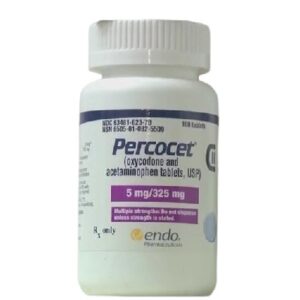Description
Oxycodone
Oxycodone is a powerful semi-synthetic opioid that is used to treat moderate to severe pain following surgery, injury, or chronic diseases such as cancer. It comes in both immediate-release (IR) and extended-release (ER) forms, with brand names like OxyContin (ER) and Percocet (IR + acetaminophen).
Medical applications include treating acute pain, such as after surgery or fractures.
Chronic pain (e.g., cancer-related or severe arthritis)
Palliative Care (pain alleviation during terminal disease)
Not approved for:
Mild pain (safer options such as NSAIDs are suggested).
Long-term use without strict supervision (high addictive risk)
How It Works.
Binds to mu-opioid receptors in the brain and spinal cord, inhibiting pain signals and causing bliss.
IR forms (e.g., Roxicodone): Work in 15-30 minutes and last 3-6 hours.
ER formulations (such as OxyContin): Release after 12 hours (cannot be crushed).
Dosage and Administration
Adults’ starting dose is 5-15mg IR every 4-6 hours as needed.
ER forms: 10–80 mg every 12 hours (for persistent pain).
Maximum daily dose: varies by patient; frequently limited to 80mg/day without tolerance.
Critical Rules:
Take precisely as instructed (never modify the dosage without visiting a doctor).
Never crush, snort, or inject ER tablets (they can cause a lethal overdose).
Avoid drinking (there is a danger of respiratory arrest).
Side effects are common.
drowsiness, dizziness, and constipation.
Nausea, dry mouth, and slight exhilaration.
Serious (Get Emergency Help):
Respiratory depression (slow, shallow breathing).
Hypotension (very low blood pressure).
Opioids cause hyperalgesia (increased pain sensitivity).
Addiction and Dependence: Schedule II restricted drug (high abuse potential).
Tolerance develops fast, leading to the risk of dose escalation.
Symptoms of withdrawal include anxiety, perspiration, diarrhea, and muscle cramps.






Reviews
There are no reviews yet.